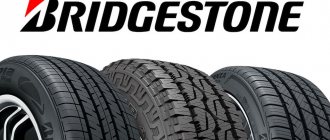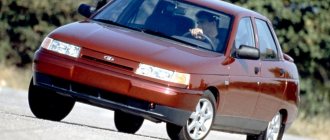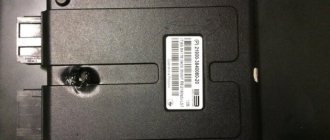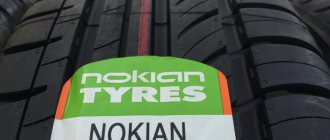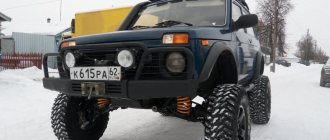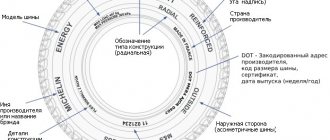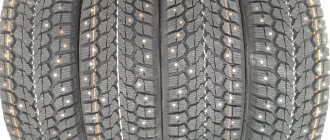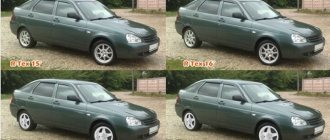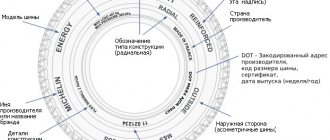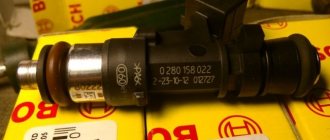"Hankuk" or "Goodyear": which is better?
"Hankuk" is a South Korean manufacturer with branches in Europe and the USA. The company produces tires for passenger cars, sports cars, trucks, as well as buses and minibuses. Year of foundation: 1941.
Innovation:
- technology for dynamic cornering at high speed;
- reduced rolling resistance to reduce fuel consumption; wide tread for good grip;
- development of tires with variable tread structure for high driving force (allows off-road driving and even in the desert);
- concept of cross-country tires with extra ground clearance;
- Water-repellent technology for improved road stability.
Hankook tire
Goodyear is an American international manufacturer. Focuses on products for cars, trucks, motorcycles, and racing cars.
Innovation:
- technology for automatically eliminating punctures up to 5 mm without the need to extract the cause;
- a method of producing rubber that reduces noise levels by 50%;
- patented 3D lamella technology that increases product rigidity and stability;
- a way to shorten braking distances on wet roads.
Goodyear began developing tires for spacecraft.
Which tires to choose: Hankuk or Goodyear
Hankuk specialists offer motorists models of winter tires for different conditions:
- regions with heavy snowfalls and low temperatures;
- control on icy roads (a special pattern on the tires has been developed).
Main characteristics:
- Rubber contains a lot of rubber - it remains soft at low temperatures;
- additional cuts on the tread provide cross-country ability on snowy roads;
- The special pattern makes it easy to drive the car off-road.
Hankook tires
Goodyear specialists focus on innovation. Main characteristics:
- low noise level thanks to proprietary technology;
- stable behavior on the road (it was possible to achieve a reduction in braking distance);
- maintaining good grip on wet roads;
- special rubber mixture ensures elasticity;
The tread pattern has many edges for safe winter driving.
Which tires are more popular?
Part of the question of whether Hankook or Goodyear winter tires are better can be answered by their level of popularity. Both companies have earned the attention of drivers due to the good quality of their products. But they set the bar higher. They have 10% more positive reviews.
What tires do car owners choose?
Buyers are more likely to lean towards Hankook. Users note the high wear resistance and controllability of the tires. For most drivers, Hankuk winter tires are better than Goodyear ones.
A little history of Kumho
ATTENTION! A completely simple way to reduce fuel consumption has been found! Don't believe me? An auto mechanic with 15 years of experience also didn’t believe it until he tried it. And now he saves 35,000 rubles a year on gasoline! Read more"
Kumho Tires is a South Korean company that occupies a leading position in the tire industry. The initial purpose of creating a company is the production of transport. The founder of the company, In-Chun Park, went through a difficult path to achieve the prosperity of his corporation.
When the difficult years of the war passed, Parcu's company was destroyed, but was subsequently restored. The company produces more than 35 million tires annually.
The date of its next foundation was in 1961. The organization was created in a city called Gwangyu. She specializes in the creation and development of automobile tires. Soon information about the company spread among wide circles of fans of unbridled racing.
Read also: Tool for installing valve stem seals
Let's compare: Bridgestone Velcro or Hankook studs
Bridgestone is a Japanese company that produces tires for different classes of cars. It separately produces products for sports cars. The manufacturer has won the trust of customers thanks to its own developments. One of the latest innovations is high, narrow tires made from a high-quality rubber compound. The strength of winter models is the correct placement of studs and an innovative composition to overcome slipping.
Which tires to choose
In cold regions without much snow, preference is given. Hankuk tires are a helper in areas where movement is hampered by frequent drifts and even snowdrifts.
Features of "Bridgestone":
- aggressive pattern for safe driving on snowy and icy roads;
- the composition of the rubber allows it not to harden at low temperatures;
- the optimal placement of the studs facilitates easy braking and control when cornering and on difficult roads;
- the reinforced spike of some models provides a strong fixation;
- V-shaped pattern improves handling on ice.
Bridgestone
The driver chooses tires depending on his driving style and climate in his region. Therefore, for every car owner, winter tires are either Hankuk or Bridgestone.
Which tires are more popular?
Bridgestone is several points behind its competitor in the popularity rating. In car blogs, chats and services, Hankook tires are often mentioned as an ideal option for winter.
Which tires do car owners choose: Hankuk or Bridgestone?
Hankook ranks five places higher in the car ownership rankings. Buyers appreciate the durability of the products. Noise and handling are above average.
Winter tires "Nordman" or "Hankuk"
Nordman tires are produced by a company from Finland. The brand has been producing tires since 1932. The first winter model entered the market in 1934. The manufacturer is focused on producing products for difficult climatic conditions: snowy roads, sudden temperature changes, icing.
Key innovations:
- Nokian Cryo Crystal technology for improved grip quality;
- winter wear indicator - a concept for safe operation (the numbers on the tread are gradually erased; the driver sees how many mm are left before complete wear);
- Silent Groove Design solution for a comfortable ride and reduced noise levels.
Nordman
The company admitted that many years of record test results were achieved in a dishonest way - by providing modified models for testing that are not sold.
Which tires to choose: Nordman or Hankook
To understand whether Nordman or Hankuk winter tires are better, you need to evaluate the features of the Finnish brand:
- low noise level due to semicircular grooves on the tread;
- safe operation with the ability to monitor the degree of tire wear;
- good grip, fast braking due to the Nokian Cryo Crystal concept (rubber contains crystal-like particles that act like spikes);
- Double studs improve grip and ensure safety when driving on ice.
Which tires are more popular?
Nordman is significantly inferior in popularity to the Hankuk brand. It is used as a more affordable replacement. Tires from the second company are less wear-resistant and are too soft on the sides.
Which tires do car owners choose: Nordman or Hankuk?
If the roads are covered with ice or snow, drivers often choose Hankuk. Models from this manufacturer are more reliable in different weather conditions. Although, according to reviews of Nordman, the product of this brand is characterized by long-term use.
Conclusions: which is better Kumho or Dunlop?
When answering the question which is better Kumho or Dunlop, it is important to take into account their main characteristics,
features, advantages and disadvantages. Considerable importance is given to real reviews. Judging by the above information, it can be understood that each of the brands is unique in its own way. What one has, the other does not and vice versa.
There are both similarities and differences between Kumho and Dunlop. But reviews prove that in the world there are supporters of both the first and second brands of tires.
In a word, the tires of these companies are equally good; it is impossible to determine a winner between them.
We wish you success in purchasing high-quality, and, most importantly, useful tires!
Cons Moderate cross-country ability in deep snow Cons Difficult acceleration control on winter roads
Pirelli Best lateral properties on ice Pros Clear handling Pros Modest fuel consumption Pros Low noise level
Cons Weak brakes on snow and asphalt, as well as longitudinal grip on ice Cons Low cross-country ability in deep snow Cons Comments on ride smoothness and directional stability on snowy roads Dunlop + Behavior on asphalt + Noise level
Cons Claims about lateral stability on snow
205/55 R16
Budget "winter"
The popular “sixteenth” tire size comes from popular brands. In this comparative test, we collected and evaluated the qualities of ten friction tires costing from 100 to 200 rubles. The cheapest of the selected tires were produced in Russia (Cordiant and Viatti) and Belarus (Belshina’s native Artmotion). But the most expensive was the Japanese Dunlop: from 200 rubles per wheel. Let's see how much more effective and safe this imported product turns out to be. Also included in the test were studded tires – Nitto Therma Spike. We did not stud them (by the way, studding one wheel will cost about 40 rubles) and decided to check how “unarmed” tires, which are designed to be used without studs, would perform.
We also remind you that during comparative tests, the characteristics of winter tires are primarily assessed, which are responsible for safe behavior on roads covered with snow or ice, as well as on wet and dry asphalt. Simply put, we evaluate the level of grip provided by the tires.
The winter part of the tests was carried out at a polar training ground on ice and snow at a temperature of -10...-8°C. The spring part of the tests took place at a temperature of +5...+7°C.
The test program for Scandinavian winter tires includes four tests on icy surfaces. Acceleration and braking on ice are the most important for any driver. In the test with braking from a speed of 25 km/h, five tires performed excellently, stopping the car in 12-13 meters. The leaders are Nokian and Cordiant. Among the outsiders, four tires of the Dunlop, Kumho and Nitto brands stopped the car almost 1.5 meters later. Belshina's result is the lagging behind, 16 meters. The same pattern of results was noted in the acceleration time test on ice.
A similar ranking of test participants was noted in the lateral grip test on ice. In this test, the car moved around an ice circle for a time. The better a particular tire provided stability on a bend, the faster the car completed a lap. The best results were shown by Nokian and Viatti tires, and the pilot noted the clear behavior and predictable handling on both of these tires. Then, with a lag of about 1.5 seconds, the test car arrived on Sava, Cordiant, Gislaved and Hankook tires. The pilot also noted that on these tires the cars begin to slide outward early, and on Hankook tires, the “grip” that seems good at first glance is replaced by a rather sharp drift into sliding. The last four tires were noted for their low lap speed, due to weak lateral grip on ice, and rather deep drifts.
A more complex and multifaceted test of tires on ice is driving on an icy track at speed. Cordiant and Nokian tires showed good and similar results, which also give the car clear and predictable driving behavior. Dunlop tires also give the car a very harmonious character, but their grip on ice is generally worse. “Belshina” showed an average time and was generally remembered for its rather predictable handling. The same cannot be said about Sava and especially Nitto tires, which behave nervously on ice: on them the car suddenly and deeply breaks into skids or drifts.
Read also: Denso spark plug catalog
Once again we are convinced that in longitudinal grip on snow - namely in acceleration and braking - the difference between the best and the worst tire is small. In this light, it is interesting to read reviews and listen to the opinions of those who, having installed tires of a new model on their car, suddenly discovered a noticeable increase or lag in performance compared to the previous tire. The data recorded by the measuring device suggests that the difference between the most grippy and the slipperiest tire on packed snow is about 7%.
This time, among budget tires, Hankook tires showed an exemplary result. The worst result is for the “unarmed” Nitto. When accelerating on snow, the spread of results increased to 15%. Six tires showed very close results with a difference of literally 5%. The outsiders were Nitto, Belshina and Sava.
But in a more dynamic test - checking handling on a snowy track - Sava tires performed exemplary. They provide good lateral grip and give the car easy handling. Viatti and Nitto tires, as well as Nokian, showed quite decent results. Less confidently, the test car rushed along the track on Hankook and Gislaved tires.
The “spring” tests of winter tires on asphalt included braking on wet and dry asphalt, as well as handling on a wet track. As often happens, in the asphalt program tires perform well that lost on ice and snow. In braking on wet asphalt, Sava tires showed the best results. The second result is for Belshina. The longest braking distance - with an extra four meters - was shown on Dunlop and Kumho tires.
Sava tires also led in handling on wet asphalt; Gislaved tires showed very close results. “Belshina” held on well, showing the 4th result. The slipperiest tires on wet asphalt were Kumho, Dunlop, Cordiant and especially Nitto.
Rolling resistance
We assessed the ease of rolling on a special stand with a metal drum. For studded tires, the studs had to be removed for this test. The rolling resistance coefficient is expressed in kg/t (or N/kN). A factor of 7 kg/t means that if a tire is weighed down by one tonne, a force of 70 N must be constantly applied to it to prevent it from losing speed due to rolling resistance. The lowest rolling resistance coefficient is found in winter tires Nokian, Hankook and Gislaved. The highest are at Cordiant and Belshin.
Have you decided to pay attention to the studded version? Do you live in the outback, where roads are rarely cleaned? The direction is chosen correctly - it is for such conditions that the stud is designed. However, at this stage the issue has not yet been resolved. It's only begining.
When you start choosing tires from a large selection without any recommendations, you can easily get confused. Therefore, many car enthusiasts often look at the ratings of winter studded tires and, as a rule, the latest reviews.
Owner ratings demonstrate the real capabilities of a particular tire in everyday conditions. You should also pay attention to the fact that different winter studded tires will have different reviews - depending on the brand, model and operating conditions.
Which winter tires are better: Hankook or Dunlop?
Dunlop tires are the result of collaboration between German and Japanese specialists. Production is established in Europe. More than 70% of shares belong to .
Innovation:
- Noise protection technology. Reduces sound level by up to 50%. A layer of polyurethane foam is built inside the tire.
- Multi Blade System. The manufacturer uses several types of patterns for winter models for different road surfaces.
- Reinforced sidewall of the tire.
"Dunlop"
If your vehicle is equipped with a TPMS system, you can purchase an innovative tire that allows you to drive 50 miles after a puncture.
Which tires to choose
Dunlops are designed for extreme winter conditions and wet roads. Owners note good handling. But according to experts, Hankook products win in a number of indicators.
Dunlop Features:
- low noise level due to protection and a layer of polyurethane foam;
- wear resistance and cornering control, which was achieved by strengthening the sidewall;
- different patterns for each type of road.
Which tires are more popular?
Winter tires from Hancock are popular among motorists (compared to Dunlop). Car owners actively discuss product characteristics on various resources.
Which tires do car owners choose: Hankuk or Dunlop?
Hanukkah ranks higher than Dunlop. Buyers note low noise, good stability and controllability.
Some differences between Kumho and Dunlop tires
Both Kumho tires and Dunlop tires have divided the middle price segment among themselves. However, Dunlop tires turned out to be more popular in the domestic market. Based on the price, buyers prefer Dunlop brand tires.
Read also: Kia Sorento all-wheel drive device
All-round Dunlop tires can handle off-road conditions with ease. But Kumho brand tires boast amazing driving characteristics and an increased level of wear resistance.
Thus, there is no significant difference between the tires of these two brands. It all depends on your taste preferences and the purpose of the rubber.
